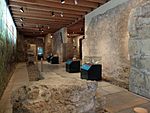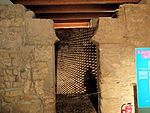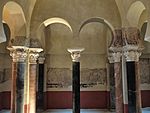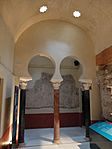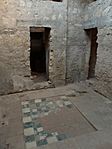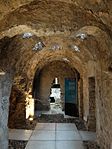Caliphal Baths facts for kids
The Caliphal Baths are an old Islamic bathhouse (also called Arab baths) in Córdoba, Spain. They are located in the old part of Córdoba. This area was named a World Heritage Site by UNESCO in 1994. The baths were right next to the old Caliphal Palaces. These palaces are now the Alcázar de los Reyes Cristianos. The baths were used by the people living in the palace. Today, parts of the baths have been rebuilt. You can visit them as a museum.
Contents
History of the Baths
Building and Use by Muslim Rulers
These baths were built in the 10th century. They were made for the palace of Caliph Al-Hakam II. He ruled from 961 to 976. Bathhouses like these were common in Muslim cities. They were important for both social life and religious washing. Muslims used them for special full-body washes called ghusl. These were needed for certain situations. The baths were also great for staying clean and meeting people.
The design of these baths was based on old Roman bathhouses. Romans had used baths in this area for a long time. The Caliphal Baths in Cordoba had the usual rooms. These were a cold room, a warm room, and a hot room.
After the Umayyad Caliphate ended in the 11th century, Cordoba was ruled by the Taifa (kingdom) of Seville. The royal palace was still used by the governor. A new reception hall was added to the bath complex during this time. You can still see parts of it today. Later, the Almoravids took over the Taifa kingdoms. Then the Almohads ruled until the early 13th century. The Almohads built another bathhouse next to the original one. It shared some parts but had its own set of cold, warm, and hot rooms.
Christian Era (After 1236)
In 1236, King Ferdinand III took over the city. He gave one part of the palace to the bishop of Cordoba. This is now the Episcopal Palace. The rest of the palace stayed a royal home. The baths continued to be used by the new Christian rulers. A new water pool was added to the Almohad baths.
About a hundred years later, in 1328, King Alfonso XI built new baths. These were for his favorite lady, Leonor de Guzmán. You can still see these baths in the Christian Alcazar. At the same time, the old Arab baths were buried. A small square called Campillo del Rey was made over them. In 1588, the square was renamed Campo Santo de los Mártires. This was to honor Christian martyrs.
In 1691, parts of the baths were found by accident. This happened during building work near the square. It's possible that some stones from the baths were used for a nearby church. The baths were covered up again. They were not found again until 1903. This happened during gardening work in the square. A Spanish historian, Rafael Ramírez de Arellano, studied them. He found they were from the time of al-Hakam II.
The baths were covered up once more. They were finally dug up and studied by archaeologists from 1961 to 1964. Because of this, the site was named a Cultural Heritage Property of Spain. The remains were later turned into a museum. It opened in 2006.
Architecture of the Baths
Entering the Bath Complex
Visitors entered the Caliphal Baths from the south. This was the direction of the palace. First, they arrived at a large changing room. This room was called the bayt al-maslah. It was like the apodyterium in Roman baths.
By the 11th century, the entrance had a sunken garden. This garden led to a portico (a covered walkway). This then led to a decorated reception hall. The garden likely had orange trees, lemon trees, and myrtles. Water came to the baths from an aqueduct along the city walls. It was also stored in a cistern.
-
These are the remains of a decorated horseshoe-arch doorway. It was in the Taifa-period reception hall.
Baths from the Umayyad Caliphate Period
The original Caliphal Baths had three main rooms. They were lined up next to the changing room, from east to west. These were the cold room (bayt al-barid), the warm room (bayt al-wastani), and the hot room (bayt al-sajun). These were like the Roman frigidarium, tepidarium, and caldarium. Toilets were also near the cold room. They had running water to wash away waste.
Bathers went to the cold room first. Then they moved to the warm room, and finally to the hot room. The hot room's job was to make people sweat. This was part of getting clean. Bathhouse staff also cleaned visitors with rubbing and massaging. In Muslim hammams, people did not soak in water. Instead, they washed themselves by having warm water poured over them at the end.
The largest room in the Caliphal Baths was the warm room. It took up about 40% of the bathing area. This was common in many baths in al-Andalus. It had a large central vault ceiling. Smaller barrel vault sections surrounded it. These rested on marble columns with fancy capitals. There were also horseshoe arches. The ceilings had small skylights, often shaped like stars, for light.
The floor and lower walls were covered in marble. The upper walls had a special lining to stop steam. The room also had some geometric designs. Not much of this decoration is left today. The smaller hot room was a rectangle. It had a barrel vault ceiling. At each end, there was a column between two horseshoe arches.
On the west side, behind a marble lattice wall, was the service area. This area was lower than the other rooms. It held the furnaces. These furnaces made hot water for the steam rooms. They also made hot air and smoke. This hot air was sent through pipes under the floors of the hot and warm rooms. This was like the Roman hypocaust system. The air then went up through the walls and out through chimneys.
The Almohad-Period Baths
The Almohad-era bath was to the west of the Caliphal Baths. It had a second set of cold, warm, and hot rooms. You could get to them from the Taifa-period reception hall. These rooms were smaller than the original Caliphal steam rooms. They used the same service area and furnaces as the old baths. The hot room here looks very similar to the hot room of the Caliphal Baths. However, the warm room is much simpler than the Caliphal one. They also had decorative plasterwork. This included floral and swirling designs. Some pieces of these designs are kept at the Archeological Museum of Cordoba.
-
This is the cold room (bayt al-barid) of the Almohad baths.
See also
 In Spanish: Baños califales (Córdoba) para niños
In Spanish: Baños califales (Córdoba) para niños
- El Bañuelo
- Hammam Saffarin
- Qusayr 'Amra
- Wudu (common Islamic ablutions)
Images for kids




